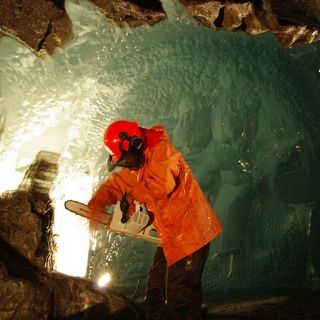Art and World Cultures a Unit 4 Lesson 2 Unit 2 Lab Quizlet
Science in Ice: Lab Operates Inside a Glacier

Well-nigh 700 feet (more than than 200 meters) under the Svartisen glacier in northern Norway, researchers are huddled together undercover. In the world's only lab located inside one of these giant hunks of ice, they are carrying out some of the all-time experiments on the movement and composition of glaciers ever done.
The lab, operated by the Norwegian Water Resources and Free energy Directorate, is located higher up the Arctic Circumvolve. It started out as a tunnel for hydropower, but then researchers persuaded the hydropower visitor to dig out 1 small extra tunnel just for them and created a valuable in-site lab.
Normally to go admission to the base of a glacier, it is necessary to drill a borehole through the ice. Doing so involves a huge logistics operation and also ways that researchers can work but where the surface water ice isn't too badly cracked. Using the new lab, researchers can visit exactly the same location at the glacier bed each time — and information technology's much easier for them to go access to the base of operations.
But the in-site lab comes with its own set of challenges.
Icy challenges
To access the remoteworkspace, researchers have to wing to a small northern Norwegian town, and so bulldoze for hours, have a ferry, walk along a dirt road and upwardly a mountain. From the entrance to the tunnel, it's another mile-plus expedition up a set of stairs to the lab. It's a one-hour walkin full when conditions are skillful, but when at that place is fresh snow to trudge through on the manner to the entrance, the slog can take iv to 5 hours. [See images of the glacier lab .]
To get to unlike parts of the glacier bed to written report how the ice slides over the stone beneath, the researchers cook additional 30- to twoscore-human foot-long (9 to 12 g) tunnels using hot h2o. "The water is heated up in a big hot-water heater that is in the main tunnel. The hot water is then pumped up the ice tunnel," said Miriam Jackson, asenior research scientist and glaciologist with the directorate. Melting a glacier from the inside out isa slow process — creating one water ice tunnel takes around 24 to 48 hours.
Working under the glacier instead of the cold surface protects the researchers from some challenges, only it's still a tough environment.
"Some people find the stress of being in the tunnel system a challenge, and although this is unusual, tempers tin can occasionally fray, especially for groups that have express feel of glaciological fieldwork," Jackson said.
Seismic signals and sliding
Once in the lab, the scientists go on their work in trying to get a read on how glaciers move and how they drain throughout the year, as well as how glaciers impact sea level ascension by contributing melt water to the oceans. The laboratory is too existence used to test and develop theories about the seismic signals — similar to those measured from earthquakes — that moving glaciers transport.
"Nosotros can put the seismic instruments in the tunnel system, they are a lot nearer to the base of the ice, whereas normally scientists must put the instruments on the surface, even when they are studying what is happening at the base," Jackson told OurAmazingPlanet.
The team just does enquiry in the wintertime to avoid meltwater, and the research expanse has room for upward to six people sharing four bedrooms, a kitchen, bathroom and a shower in addition to three laboratories, a walk-in freezer, a workshop and a water heater. Most of the time at that place are just 3 to four people in the labfor a period of half dozen to 7 days betwixt November and Apr.
Recent experiments measured the resistance to sliding at the base of operations of the glacier and constitute that most of the resistance is due to the friction between the debris-rich ice and the bedrock — a finding that was a surprise. Previously researchers thought that ice period past particular obstacles in the bedrock provided well-nigh of the resistance to friction of the glacier.
The ice tunnel labs provide the researchers with more than just a inquiry site, though.
"One of the most surprising things is the beauty," Jackson said. "Each fourth dimension we melt out an ice tunnel information technology is equally entrancing."
This story was provided by OurAmazingPlanet, a sis site to LiveScience. Follow OurAmazingPlanet on Twitter @OAPlanet. We're also on Facebook and Google+.
Source: https://www.livescience.com/25931-lab-inside-glacier.html
0 Response to "Art and World Cultures a Unit 4 Lesson 2 Unit 2 Lab Quizlet"
Post a Comment